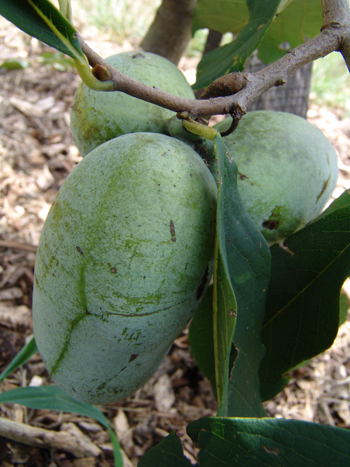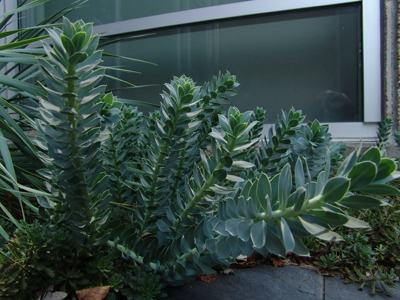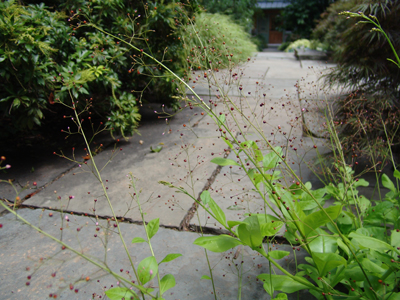Plants of the Week – August 6
 When I say Lycoris, I am not referring to Licorus Black, the evil pure-blood middle child of Sirius Black II and Hesper. And if someone mentioned Naked Ladies lining Magill Walk, let it be known they are referring to Lycoris, the lovely lily-esque flowers that are currently in bloom. One of the common names for this summer-blooming bulb is naked ladies due to the stalks shooting straight up from the soil with no foliage, their leaves having died back earlier in the summer. Other common names for Lycoris include magic lily, naked lily, resurrection lily, and spider lily. These are herbaceous perennial bulbs which produce foliage from winter or early spring until July when they die back. The flowers follow, borne on an umbel atop talk thin stalks. Lycoris tends to like shaded areas; the native species was originally found in shaded woodlands in Asia. Each of the Lycoris stalks shown above is a different species from left to right: L. squamigera, L. sprengeri , and L.chinensis. photo credit: J. Ahrweiler
When I say Lycoris, I am not referring to Licorus Black, the evil pure-blood middle child of Sirius Black II and Hesper. And if someone mentioned Naked Ladies lining Magill Walk, let it be known they are referring to Lycoris, the lovely lily-esque flowers that are currently in bloom. One of the common names for this summer-blooming bulb is naked ladies due to the stalks shooting straight up from the soil with no foliage, their leaves having died back earlier in the summer. Other common names for Lycoris include magic lily, naked lily, resurrection lily, and spider lily. These are herbaceous perennial bulbs which produce foliage from winter or early spring until July when they die back. The flowers follow, borne on an umbel atop talk thin stalks. Lycoris tends to like shaded areas; the native species was originally found in shaded woodlands in Asia. Each of the Lycoris stalks shown above is a different species from left to right: L. squamigera, L. sprengeri , and L.chinensis. photo credit: J. Ahrweiler
 Asimina triloba is a native tree of the Annonaceae family which is starting to produce its fruit, the largest fruit native to America. This tree is native to the temperate woodlands of the eastern United States, has a small stature rarely growing higher than 25 feet tall, and has dense drooping foliage. The tree’s claim to fame, however, is its fruit the pawpaw. The pawpaw looks like a short, squat banana with a custardy texture and a tropical taste; many sources say it’s like a cross between a mango and a banana or a melon and a banana. Not only is it a tasty fruit but current research says it is highly nutritious with double the calcium of apples, high levels of minerals, proteins, and antioxidants; and one source mentions it contains as much anti-oxidant as a cherry. Although the pawpaw is rarely sold commercially, domestication is well underway. If you would like to try growing pawpaws on your own, the trees grow best in deep and highly fertile soil that is well drained and slightly acidic. Two trees may be required for cross pollination and fruiting. photo credit: J. Ahrweiler
Asimina triloba is a native tree of the Annonaceae family which is starting to produce its fruit, the largest fruit native to America. This tree is native to the temperate woodlands of the eastern United States, has a small stature rarely growing higher than 25 feet tall, and has dense drooping foliage. The tree’s claim to fame, however, is its fruit the pawpaw. The pawpaw looks like a short, squat banana with a custardy texture and a tropical taste; many sources say it’s like a cross between a mango and a banana or a melon and a banana. Not only is it a tasty fruit but current research says it is highly nutritious with double the calcium of apples, high levels of minerals, proteins, and antioxidants; and one source mentions it contains as much anti-oxidant as a cherry. Although the pawpaw is rarely sold commercially, domestication is well underway. If you would like to try growing pawpaws on your own, the trees grow best in deep and highly fertile soil that is well drained and slightly acidic. Two trees may be required for cross pollination and fruiting. photo credit: J. Ahrweiler
 In the Harry Wood Garden, I found Euphorbia myrsinites planted next to a blue yucca. This euphorbia is a low growing herbaceous perennial with a sprawling or trailing habit, beautiful blue foliage, and striking texture. Paired with the yucca, the two strong forms create an attractive contrast. Euphorbia myrsinites grows well in dry, well-drained soil in full sun and would make a great plant for a rock garden or edging stone walls as it performs well in poor soils. It is an evergreen and keeps its foliage through winter, though in colder temperatures it may lose some foliage. In spring, it will bloom with clusters of small yellow flowers, but its blue spiraling foliage interests me the most. photo credit: J. Ahrweiler
In the Harry Wood Garden, I found Euphorbia myrsinites planted next to a blue yucca. This euphorbia is a low growing herbaceous perennial with a sprawling or trailing habit, beautiful blue foliage, and striking texture. Paired with the yucca, the two strong forms create an attractive contrast. Euphorbia myrsinites grows well in dry, well-drained soil in full sun and would make a great plant for a rock garden or edging stone walls as it performs well in poor soils. It is an evergreen and keeps its foliage through winter, though in colder temperatures it may lose some foliage. In spring, it will bloom with clusters of small yellow flowers, but its blue spiraling foliage interests me the most. photo credit: J. Ahrweiler
 The Jewels-of-Opar have raised many questions this summer. They were much overlooked until their flowers turned into a plethora of tiny multi-colored shiny spheres resembling jewels, hence its common name. This self-seeding annual, Talinum calycinum, is an intriguing annual with unusual seed heads and chartreuse foliage. The Talinum found in the Scott Entrance Garden and Terry Shane Teaching Gardens were self-seeded from the previous year. We let it grow in many places where it seeded due to the interest these little ‘jewels’ bring. This annual likes rocky or sandy soil and requires the site to be well-drained. I’ve even seen seedlings growing in cracks between bricks in a walkway. photo credit: J. Ahrweiler
The Jewels-of-Opar have raised many questions this summer. They were much overlooked until their flowers turned into a plethora of tiny multi-colored shiny spheres resembling jewels, hence its common name. This self-seeding annual, Talinum calycinum, is an intriguing annual with unusual seed heads and chartreuse foliage. The Talinum found in the Scott Entrance Garden and Terry Shane Teaching Gardens were self-seeded from the previous year. We let it grow in many places where it seeded due to the interest these little ‘jewels’ bring. This annual likes rocky or sandy soil and requires the site to be well-drained. I’ve even seen seedlings growing in cracks between bricks in a walkway. photo credit: J. Ahrweiler





No Comments